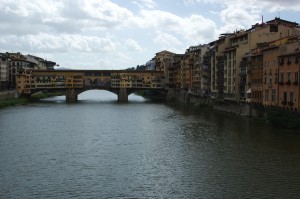Let’s be honest.
We often don’t know what we’re looking at.
The Grand Canyon. The Eiffel Tower. The treasures of Florence. A guide can enhance our understanding and appreciation of what our eyes take in.
A good guide can make us see things in an entirely new way.
Our group of six spent most of the day with one of the finest guides in Florence, our friend Paola.
She knows the city, she knows its history, and she knows its art — in ways non-artists like us are unlikely to see. For example:
She showed us how a series of well-executed frescos in an obscure church demonstrated something resembling the birth of marketing. With a message “brought to you by” the artist’s patron — who was keen to impress the subject of the frescos and was prominent in a way most of us would not notice. It ostensibly was about Saint Francis of Assisi.
In reality, it was about flattering the most powerful man in Florence, which was done by where the light fell, where the eye leads the viewer, by the placement of people in the art. She compared it to an important sports event, with commercials for Coke, who pay for the rights to have media displayed — in this case, frescos in 15th century Florence.
–The Palazzo Strozzi looks like another large stone building. But it represents an expression of ego by an important man during the 16th century. His largely horizontal structure, in a crowded city demonstrated his wealth and also demonstrated how Florence’s early lead in international banking helped make the city wealthy, and much of that wealth was channeled into the arts.
–She showed us, from a few feet away, some of the subtleties of Michelangelo’s David, which to most of us looks like a young guy wearing nothing but a sling. She demonstrated how the furrows in his brow demonstrated his doubt in his ability to kill Goliath, and how from the (our) right side of the statue in looks as if David has not yet decided on a course of action. But from the (our) left, the flex of muscles in his hand (holding the stone) and are suggest he is about to spring into action.
–She demonstrated the multiple readings of The Rape of the Sabine Women by Giambologna. It is far more sophisticated and nuanced than the title (and our vision) might suggest. From one perspective, it looks like a violent abduction. But from another it looks like a tender love scene and from a third it seems as if the primary male figure is rescuing the woman, perhaps from the cowering man at the bottom of the statue.
–Another famous statue in the Loggia of Florence, Perseus with the Head of Medusa, turns into a paean from the artist to himself. Knowing that his work was headed for Florence, to be compared to David, Benvenuto Cellini not only wrote his name on the only scrap of “clothing” (a belt angled across the youth’s body,) on the statue, but if we circle around to view it from behind we can see Cellini’s face not-quite-hidden in the hair of the statue.
A good guide makes more accessible our every encounter with something grand — which happens every few steps, in Florence. He or she gives context and meaning, and allows us to place it into a coherent whole. “This happened because that was going on, and it was done this way because a trade route had just been opened to …”
Paola reminded us of how an expert can make us better appreciate the art in front of our faces.
Our group was most grateful to her for improving our vision of a great city, and for reminding us that we “lay” people nearly always benefit by having an expert along.


0 responses so far ↓
There are no comments yet...Kick things off by filling out the form below.
Leave a Comment